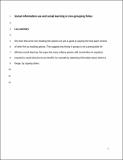Files in this item
Social information use and social learning in non-grouping fishes
Item metadata
| dc.contributor.author | Webster, Michael Munro | |
| dc.contributor.author | Laland, Kevin Neville | |
| dc.date.accessioned | 2018-09-10T23:35:39Z | |
| dc.date.available | 2018-09-10T23:35:39Z | |
| dc.date.issued | 2017-11-13 | |
| dc.identifier | 251081447 | |
| dc.identifier | 127a198f-65bd-49ae-9aa5-fa5fa554c4ef | |
| dc.identifier | 85043979860 | |
| dc.identifier | 000415675000018 | |
| dc.identifier.citation | Webster , M M & Laland , K N 2017 , ' Social information use and social learning in non-grouping fishes ' , Behavioral Ecology , vol. 28 , no. 6 , pp. 1547-1552 . https://doi.org/10.1093/beheco/arx121 | en |
| dc.identifier.issn | 1045-2249 | |
| dc.identifier.other | ORCID: /0000-0001-9597-6871/work/60427812 | |
| dc.identifier.other | ORCID: /0000-0002-2457-0900/work/60630369 | |
| dc.identifier.uri | https://hdl.handle.net/10023/16001 | |
| dc.description | Funding: NERC (NE/D010365/1) and European Research Council advanced grants (EVOCULTURE 232823). | en |
| dc.description.abstract | Although it is natural to expect that group-living animals will utilize social learning, the expectation for non-grouping species is less clear. Only a few studies have explored the relationship between sociality and social learning. Here we presented 4 non-grouping fish species, fifteenspine sticklebacks (Spinachia spinachia), bullhead sculpins (Cottus gobio), stone loach (Barbatula barbatula) and juvenile European flounders (Platichthys flesus) with social information provided by groups of a shoal-forming heterospecific, the threespine stickleback (Gasterosteus aculeatus). Using a binary choice procedure we allowed individual test subjects to select between simulated prey patches. Although the test subjects could not sample the patches directly they were able to use information generated by the heterospecific demonstrators to select the “richer” of the 2 patches. For comparison we also recorded social information use in 2 shoaling species, threespine, and ninespine sticklebacks (Pungitius pungitius). We saw evidence of social information use and social learning in all 6 species, with no differences seen between social and non-grouping species. We argue that social learning is not likely to be restricted to group-living species, since many solitary species too are regularly exposed to social stimuli from both conspecifics and heterospecifics, and can benefit from using social information. We suggest that researchers have much to learn about the sensory, perceptive, and cognitive mechanisms underlying social learning, and the extent to which these vary (if at all) between grouping and non-grouping species. | |
| dc.format.extent | 6 | |
| dc.format.extent | 587008 | |
| dc.language.iso | eng | |
| dc.relation.ispartof | Behavioral Ecology | en |
| dc.subject | Copying | en |
| dc.subject | Learning | en |
| dc.subject | Producer-scrounger | en |
| dc.subject | Social information | en |
| dc.subject | Social learning | en |
| dc.subject | QH301 Biology | en |
| dc.subject | DAS | en |
| dc.subject | BDC | en |
| dc.subject | R2C | en |
| dc.subject.lcc | QH301 | en |
| dc.title | Social information use and social learning in non-grouping fishes | en |
| dc.type | Journal article | en |
| dc.contributor.sponsor | NERC | en |
| dc.contributor.sponsor | European Research Council | en |
| dc.contributor.institution | University of St Andrews. School of Biology | en |
| dc.contributor.institution | University of St Andrews. Centre for Social Learning & Cognitive Evolution | en |
| dc.contributor.institution | University of St Andrews. Scottish Oceans Institute | en |
| dc.contributor.institution | University of St Andrews. Institute of Behavioural and Neural Sciences | en |
| dc.contributor.institution | University of St Andrews. Centre for Biological Diversity | en |
| dc.identifier.doi | 10.1093/beheco/arx121 | |
| dc.description.status | Peer reviewed | en |
| dc.date.embargoedUntil | 2018-09-11 | |
| dc.identifier.grantnumber | NE/D010365/1 | en |
| dc.identifier.grantnumber | en |
This item appears in the following Collection(s)
Items in the St Andrews Research Repository are protected by copyright, with all rights reserved, unless otherwise indicated.

